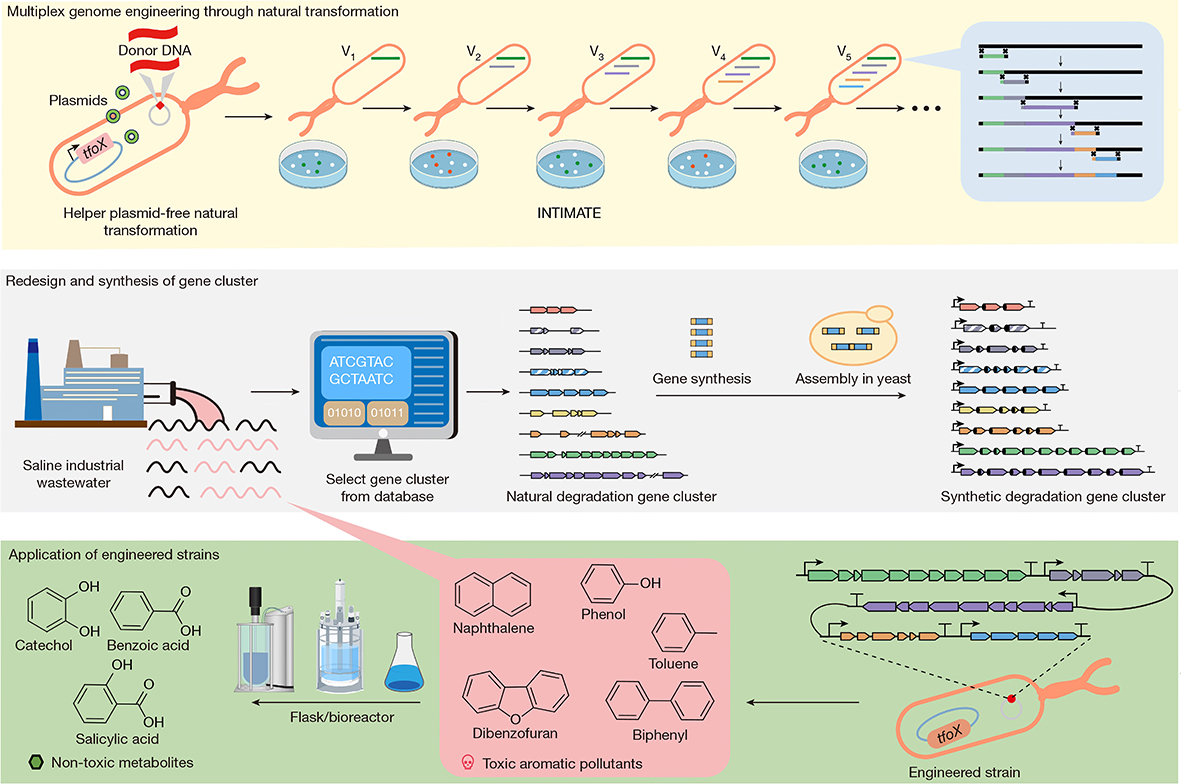By YAN Fusheng
As industrial pollution continues to contaminate ecosystems worldwide, researchers have engineered a breakthrough solution: a single bacterial strain that can tackle five persistent organic pollutants at once.
Organic pollutants—such as toluene, phenol, naphthalene, biphenyl, and dibenzofuran—are notorious for their toxicity and persistence, contaminating everything from industrial wastewater to marine environments. While nature provides bacteria that can remediate these compounds, these microorganisms can only play a very limited role: they typically specialize in breaking down only one or a few similar pollutants, and many have difficulty to survive harsh conditions like high-salinity environments where contamination is often most severe.
Recognizing these limitations, a research team led by Dr. DAI Junbiao from the Agricultural Genomics Institute at Shenzhen, Chinese Academy of Agricultural Sciences, who also leads a team at the CAS Shenzhen Institute of Advanced Technology (SIAT), and Prof. TANG Hongzhi from Shanghai Jiao Tong University set out to engineer a better solution. As a result, their study, published in Nature on May 7, 2025, successfully created a single “super-bacterium” capable of remediating multiple pollutants simultaneously.
The team’s effort to create the engineered strain, dubbed VCOD-15, began by identifying five distinct gene clusters from various naturally occurring bacteria, each containing the molecular machinery needed to break down one of the target pollutants. These gene clusters can be taken as specialized toolkits—one for toluene, another for phenol, and so on. The challenge was how to integrate all five toolkits into a single, efficient bacterial worker without causing conflicts or overwhelming the host organism.
For the chassis—the base organism that would house all these new capabilities—the team chose Vibrio natriegens. This selection was strategic for several compelling reasons: it’s one of the fastest-growing bacteria known to science, with a doubling time of less than 10 minutes; it naturally thrives in salty conditions where many pollutants are found; and it’s highly amenable to genetic modification. This ultra-fast growing, non-pathogenic bacterium is increasingly gaining attention as a superior alternative to the traditional workhorse Escherichia coli for biotechnology applications.

Schematic of the development of bacterial strain Vibrio natriegens VCOD-15, which can remediate five organic pollutants. (Graphic: Su, et al., 2025)
To make this complex genetic engineering possible, the researchers developed an innovative method called “iterative natural transformation based on Vmax with amplified tfox effect” (INTIMATE). A key breakthrough of the method involved inserting a gene called tfox into the genome of V. natriegens, which acts like a master key, boosting the bacterium’s ability to take up large DNA fragments.
Using INTIMATE, the team sequentially inserted five redesigned gene clusters—totaling 43,000 DNA base pairs—into the bacterium’s second chromosome, to create the VCOD-15 super-strain.
The performance of the new strain was striking. In laboratory cultures under saline conditions, VCOD-15 removed 100% of biphenyl, 89.9% of toluene, 89.3% of dibenzofuran, 71.8% of naphthalene, and 60.7% of phenol within just 48 hours. In real industrial wastewater from chlor-alkali plants and petroleum refineries, VCOD-15 successfully removed over 90% of all five pollutants. The bacterium even outperformed a consortium of five individual specialist strains when treating pollutant mixtures.
Using stable isotope tracing, researchers confirmed that VCOD-15 was genuinely degrading pollutants along expected metabolic pathways, transforming them into less harmful compounds like catechol, benzoic acid, and salicylic acid.
Despite the visible advantages, the scientists are candid about areas for improvement. Currently, VCOD-15 cannot use pollutants as its primary food source and requires external carbon sources like yeast extract during treatment. This is a crucial area for future improvement, as engineering the bacteria to fully mineralize pollutants—breaking them down completely into harmless substances like carbon dioxide and water—and use them for energy would make the process more self-sustaining and cost-effective.
Another consideration is performance in low-salinity environments. While salt tolerance is advantageous in industrial settings, VCOD-15 doesn’t grow as well in less salty conditions, potentially limiting applications in coastal zones with fluctuating salinity.
On the other hand, environmental safety remains paramount for releasing genetically modified bacteria. The researchers propose several biocontainment strategies, including “suicide loops:” a type of genetic system that triggers controlled cell death once remediation is complete; and biosensor-regulated DNA elements that activate remediation machinery only when pollutants are detected, and potentially trigger self-destruction when pollutants are cleared.
The INTIMATE system offers a robust platform for future advancements. Scientists envision expanding VCOD-15’s capabilities to tackle other marine pollutants like azo dyes, organohalides, and microplastics by incorporating additional degradation gene clusters.
As Tom Ellis from Imperial College London noted, this research represents “an exciting demonstration of state-of-the-art synthetic biology” and “a major achievement in synthetic biology in terms of the technologies used and the application.”
The journey from lab concept to environmental solution proved challenging—researchers first witnessed VCOD-15 simultaneously removing all five pollutants on August 31, 2022, but validating real-world efficacy required 20 months of testing with industrial wastewater samples and complex experimental setups.
This work demonstrates sophisticated “design-build-test-learn” synthetic biology, providing not just a powerful bioremediation tool, but laying groundwork for engineering next-generation microbes with expanded capabilities and enhanced safety features—paving the way for engineered bacteria to play a crucial role in healing our polluted planet.
Reference
Su, C., Cui, H., Wang, W., et al. (2025) Bioremediation of complex organic pollutants by engineered Vibrio natriegens. Nature. doi:10.1038/s41586-025-08947-7
Weinstock, M. T., Hesek, E. D., Wilson, C. M., & Gibson, D. G. (2016) Vibrio natriegens as a fast-growing host for molecular biology. Nature Methods, 13(10), 849-851. doi:10.1038/nmeth.3970

